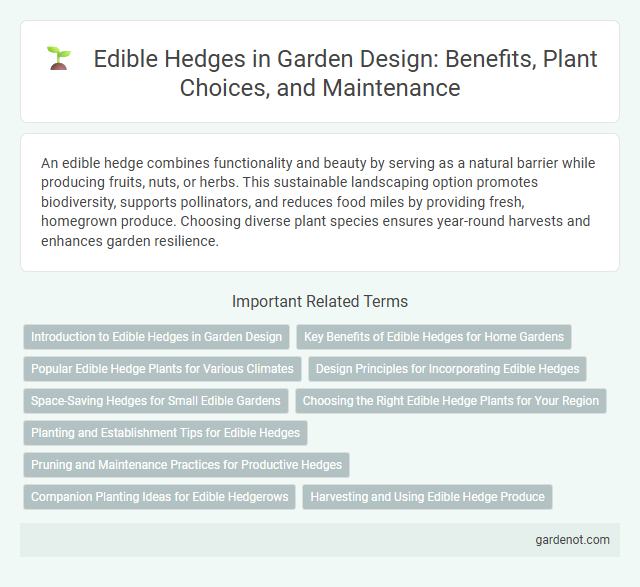An edible hedge combines functionality and beauty by serving as a natural barrier while producing fruits, nuts, or herbs. This sustainable landscaping option promotes biodiversity, supports pollinators, and reduces food miles by providing fresh, homegrown produce. Choosing diverse plant species ensures year-round harvests and enhances garden resilience.
Introduction to Edible Hedges in Garden Design
Edible hedges integrate fruit-bearing and nut-producing plants into traditional garden boundaries, enhancing both aesthetics and functionality. These living fences provide seasonal harvests while supporting biodiversity and soil health within garden ecosystems. Incorporating species like blackberries, hazelnuts, or currants creates visually appealing, sustainable barriers that maximize space efficiency.
Key Benefits of Edible Hedges for Home Gardens
Edible hedges provide multiple benefits for home gardens, including enhanced biodiversity by attracting pollinators such as bees and butterflies. They serve as natural windbreaks and privacy screens while producing fresh fruits, nuts, or herbs, reducing grocery costs and food miles. These hedges improve soil health through organic matter accumulation and encourage sustainable gardening practices by minimizing chemical inputs.
Popular Edible Hedge Plants for Various Climates
Popular edible hedge plants for various climates include native species like hawthorn, which thrives in temperate zones and offers nutrient-rich berries. In Mediterranean climates, plants such as rosemary and bay laurel provide aromatic foliage and are drought-tolerant. Hardy varieties like sea buckthorn and blackthorn adapt well to colder regions, producing vitamin-packed fruits that support both biodiversity and sustainable food production.
Design Principles for Incorporating Edible Hedges
Incorporating edible hedges into landscape design requires careful selection of plant species that balance aesthetics, functionality, and yield, emphasizing native or climate-adapted varieties like blueberry, hawthorn, or currants to maximize growth success. Proper spacing ensures adequate air circulation and sunlight, reducing disease risk while facilitating easy harvesting. Integrating diverse edible plants with varying heights and textures enhances visual appeal and supports biodiversity, creating a sustainable and productive boundary feature.
Space-Saving Hedges for Small Edible Gardens
Space-saving edible hedges maximize productivity in small gardens by combining compact plant varieties with vertical growth habits. Popular options include dwarf fruit trees, berry bushes like gooseberries and currants, and herbs such as rosemary or lavender that serve dual purposes as hedges and culinary ingredients. These dense, multi-functional plants create natural boundaries while yielding fresh produce without occupying extensive ground space.
Choosing the Right Edible Hedge Plants for Your Region
Selecting the right edible hedge plants depends on your region's climate, soil type, and water availability to ensure optimal growth and yield. Native species like hazelnut, blackthorn, or bayberry thrive in temperate zones, while drought-tolerant options such as olive or pomegranate suit Mediterranean climates. Assessing hardiness zones and local pest resistance enhances the sustainability and productivity of your edible hedge.
Planting and Establishment Tips for Edible Hedges
Select hardy, native fruiting shrubs like blackberries, currants, or gooseberries for edible hedges to ensure adaptability and productivity. Space plants 30-45 cm apart to encourage dense growth and use well-draining soil enriched with organic compost for optimal root development. Regular pruning during the first two years promotes stronger branches and higher yields, while consistent watering supports establishment without waterlogging.
Pruning and Maintenance Practices for Productive Hedges
Pruning edible hedges regularly encourages dense foliage and maximizes fruit production by removing dead or overcrowded branches. Maintain optimal sunlight exposure and airflow through strategic trimming to prevent diseases and support healthy growth. Use clean, sharp tools during pruning sessions to reduce damage and promote quicker healing in plants like berry bushes and fruit trees.
Companion Planting Ideas for Edible Hedgerows
Companion planting in edible hedgerows enhances biodiversity and pest control by combining fruiting shrubs like currants with nitrogen-fixing plants such as clover or lupines, which improve soil fertility. Incorporating herbs like rosemary and lavender attracts beneficial pollinators and repels harmful insects, boosting fruit production. Strategic layering with berry bushes, herbs, and flowering plants creates a resilient ecosystem that supports both plant health and edible yield.
Harvesting and Using Edible Hedge Produce
Harvesting edible hedge produce requires timely picking when fruits and leaves reach peak ripeness, ensuring maximum flavor and nutritional value. Common edible hedge plants like blackberries, hawthorn berries, and sea buckthorn yield abundant fruits ideal for fresh consumption, jams, jellies, and syrups. Utilizing edible hedge leaves, such as rosemary or bay, enhances culinary dishes with fresh, aromatic flavors while promoting sustainable gardening practices.
Edible hedge Infographic

 gardenot.com
gardenot.com